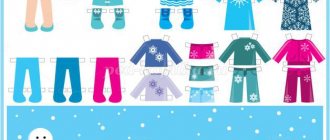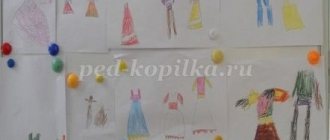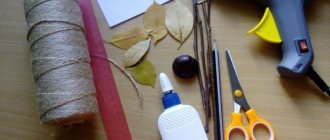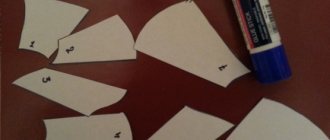Progress of the lesson:
1. Organizational moment (on the carpet)
The speech therapist tells the children that Dunno visited here and lost something from us
in Group . Offers to look around and find what he left. /Children
walk through the group and find hidden shoes and name them/
2. Game “Find a Pair”
,
“One-many”
/Children select a pair for the found one
shoes / (sitting on the carpet)
Consolidating the use of nouns in the singular and
plural, generalizing the concept of “ shoes ”
.
Boot - boots
Boot - boots
Shoe - shoes
Felt boots - felt boots
Setting the goal of the lesson : “Today we will talk about shoes ”
.
3. Exercise “What’s missing?”
The speech therapist exposes shoes (boots, boots, felt boots,
shoes). Invites children to carefully look and remember the shoes that
In front of them. Then he asks the children to close their eyes and removes one of the pairs of shoes .
He asks: “What’s missing?”
The speech therapist gives a speech sample:
“There are no more...”
(boot, boots, felt boots, shoes)
.
4. Mini-conversation about the purpose of shoes (sit on chairs)
– what are shoes ?
– how should you care for your shoes ?
- what would happen if there were no shoes ?
5. Game “Help Dunno”
/pictures are placed on a magnetic board
/ - Dunno asks you to help take apart the shoes . What are the shoes ?
which one is worn in winter? (winter)
.
Find and name winter shoes / children call felt boots,
boots/(The speech therapist places the named shoes under the picture with the image
winter)
— What is the name of the shoes that are worn in the summer? (summer)
- Find and name summer shoes / children name sandals, shoes,
sandals/ (The speech therapist places the named shoes under the picture with
summer image)
— What is the name of the shoes that men wear? (male)
– What is the name of the shoes that women wear? (female)
- Well done guys, you were very attentive and helped Dunno
name winter and summer shoes .
6. Dynamic pause with the ball game “On the contrary”
(standing on the carpet)
clean - dirty, winter - summer, long - short, new -
old
7. Finger gymnastics “Let’s count
the shoes ” (sitting on the carpet)
Let’s count for the first time how many shoes we have :
Shoes, slippers, boots,
For Natasha and Seryozha,
And even boots
For our Valentine.
And these boots
For baby Galenka.
-Let's remember what shoes we counted (shoes, slippers, boots,
boots, felt boots)
8. Game “The girl and the doll”
-Our doll Natasha will help us play this game. (shows the doll)
Let's compare the girl and the doll. (The girl is big and the doll is small)
.
Look at the girl's shoes and the doll . (The girl has big shoes . The doll has
small shoes.)
- Listen to what I call the doll’s shoes so that it is clear that she
small: the girl has shoes, the doll has shoes. Now I will show
pictures, and you will name the girls' shoes and dolls . Name the shoes
doll so that it is clear that she is small.
Shoes-shoes
slippers
ankle boots
boots
9. Drawing up proposals for the action to be performed, consolidation
prepositions on, in (sitting on chairs)
The speech therapist asks the children to fulfill his request and tell them what he did.
- Dima, please put the shoes in the box. What did you do? (I put
shoes in a box.)
– What did Dima do (Dima put the shoes in the box.)
(Similar: I put my felt boots on the floor. I put the shoes in a bag.
I put my sandals on the chair).
Well done! We made beautiful sentences and didn’t forget to say
small
the words "on"
and
"in"
.
10. Summary of the lesson
-What did we talk about today?
-What is the name of the shoes that are worn in winter?
— What is the name of the shoes that are worn in the summer?
— How should you care for your shoes ?
•If a 4-5 year old child softens all sounds: “Kisya”
,
“shchapka”
,
“cache”
,
“lampotka”
- seek
advice from a speech therapist or psychologist.
In one case, the child has a speech disorder, in another case, perhaps, psychological problems, and the child thus attracts your attention. •If a child is deafened by voiced consonant sounds: b, d, d, and possibly also c, h, g - contact a speech therapist and audiologist.
• If the child distorts sounds, that is, “burrs, nasally, lisps”
Contact a speech therapist at any age, because sound distortions will not correct themselves.
• If a child aged 3.5 - 4.5 years does not pronounce the sounds k, g or replaces them with the sounds t, d - see a speech therapist.
• If a child aged 4.5 - 5 years does not pronounce the sounds sh, zh, shch, ch, s, z, ts, l, l, th - see a speech therapist.
.
• Talk to your child more.
Even if you are silent by nature, still talk to your baby. A child understands speech addressed to him more easily if it explains what is happening around him. Therefore, accompany your actions with words.
• Voice any situation.
The child must see and hear you. Don't talk into emptiness, look into his eyes. This is especially important if your child is overly active, constantly moving, if your baby is still babbling or says few words. Try to let him see your articulation.
• Speak simply, clearly, pronouncing every word and phrase clearly.
Children are very sensitive to intonation, so try to pronounce each word that has logical emphasis as expressively as possible.
• Repeat the same word and phrase many times,
changing the order of words: “The bird has flown! A beautiful bird has arrived! A bird flew in and sat on the window! What a beautiful bird! Who is sitting on the window? The bird is sitting! Come to us, little bird!” This makes it easier for the child to hear and understand: phrases are divided into words. If you want your child to learn a word, try to use it in different contexts and more than once. After some time, be sure to look at the birds in a book, on the street during a walk, and feed the birds.
• Don't use too many long phrases.
Do not overload your child by presenting him with a large number of obviously unfamiliar words at once.
•Very important: good mood.
Try to pronounce a new word in an emotionally favorable situation. Psychologists have noticed: in such conditions, the child learns and absorbs information 10 times better than in neutral or unfavorable conditions.
• Learn new things in different ways.
It is very important that a child, while comprehending or learning something new, has the opportunity not only to see a new object, but also to touch, smell, feel it. If you see that a child is touching something or playing with something, immediately name this object several times - briefly, clearly, expressively.
• Accept and support his desire to contact you.
Even if he doesn't speak at all, engage him in non-verbal dialogue more often, "welcoming and approving"
any answer
(gesture, expressive look)
.
Support his desire to communicate. “Dya-dya-dya, ma-ma-ma, ba-ba-ba, bya-bya-bya”
; with different vowels:
“ba-bo-bu-be-bya-bi
. Combine different syllables and try to make your baby want to repeat them.
• Respect his attempts to speak.
In those moments when the child speaks or babbles alone or with you, turn off the loud music and try to give him the opportunity to hear you and himself. Speech develops on the basis of imitation and self-imitation - so he needs to hear himself.
• While playing, learn to imitate.
Play games "Two dogs are barking"
,
“Two pussies are meowing”
,
“We are in the forest: ow – ow”
. Specially create play situations where the child will need onomatopoeia, or will need to pronounce some words in order for the game to take place. Please note: it is not you who motivates, but the situation.
• Expand your baby's vocabulary.
A child speaks words on two levels: understands words - this is a passive dictionary, speaks - this is an active one. The active vocabulary can be quite small. But if you replenish the resource of understanding, this will certainly lead to the so-called lexical explosion . And in the future, he will transfer into the active dictionary what you taught him by looking at pictures together, reading books and commenting on his actions. Try to introduce into the active dictionary the names of things that surround him (toys, kitchen utensils, household items, the names of animals and creatures in pictures and books, and of course, the names of relatives and close people. Teach your child to show where the hands are, where the legs are dolls, you have)
.Ask often:
“Where is the table?
Where is the clock? etc. Then
“What is this?”
• Develop phonemic awareness.
Encourage you to distinguish words that differ in one sound (rat - roof, nose - knife)
: “Look, this is the roof. Where's the roof? Here's the roof. This is a rat. Where is the rat? Here's a rat. Where's the roof? Where's the rat?
• Read short poems, fairy tales.
Reread them many times . Don't be afraid that your child will get tired of it. Children perceive texts that they have heard many times before much better. If possible, try to act out the poem - show it in faces and with objects; and give these objects to the child to play with. Wait until the child remembers the poem well, catches its rhythm, and then try not to finish the last word of each line, letting the child do it. Sing simple songs to help him perceive and reproduce the rhythm.
• Pay attention to the development of fine motor skills - precise movements of the fingers.
Modeling, drawing, finger theater, playing with small objects - all this will help speech , and in the future, writing.
• Only you.
Remember: only you and your faith in his strengths and abilities will help your child develop harmoniously.
• Insufficient experience of communicating with adults –
will influence when adults speak very little to the baby and the child lacks the words he hears. Adults reduce their treatment of the child to a minimum; their speech mainly consists of prohibitions such as “no”
and
. ” In addition, the adult’s speech itself plays a role - its correctness and richness.
Summary of an integrated lesson in a middle group with children with special needs “Toys”
SOFTWARE CONTENT:
Educational objectives:
To form in children the general concept of “Toys”
.
Teach children to dramatize a poetic text.
Practice finding the missing part of a toy . Reinforce techniques for careful gluing.
Learn to distinguish means of musical expression: character, rhythm.
Rhythmically reproduce a simple rhythmic pattern.
Corrective tasks:
Enrich and activate vocabulary on the topic “Toys”
.
To consolidate children's knowledge of the names of modes of transport and the professions of the people who operate them.
Continue to teach word agreement in a phrase in the Accusative and Genitive cases without a preposition.
Improve the syllable structure of words with two and three syllables.
Practice using the preposition NA in speech .
Practice coordinating speech with movements .
Developmental tasks:
Develop auditory perception and memory, voluntary attention.
Develop intonation expressiveness of the voice.
Develop expressiveness in conveying movements in the text of poetry.
Educational tasks:
Develop a culture of speech in children : do not shout, do not interrupt their comrades.
PROPAEDEUTIC WORK:
Reading and looking at books by A. Barto “Toys”
, memorizing poems
“Toys”
, looking at toys, identifying and naming their parts.
VOCABULARY WORK:
Nouns: toys: airplane, boat, bull, elephant, kid, horse, matryoshka, bull, bear, frogs; transport: car, train; pilot, pilot, captain; parts of toys: wing, paw, wheel, sail, tail.
Verbs: build, jump, sleep, love, stroke, pull, glue, sing, dance.
Adjectives: beloved, beautiful, sad.
Adverbs : fun, quietly, loudly, quickly.
Pronouns: mine, mine, mine, ours.
MATERIAL FOR THE CLASS :
In the music room: toys: airplane, boat, bull, elephant, kid, horse, matryoshka; frog hats, bears, bulls, caps for the captain, handkerchief; soft module for “airplane”
, book by A. Barto
“Toys”
.
In the group : pictures depicting toys without any part: a bear without a paw, a plane without a wing, a car without wheels, a ship without a sail, a horse without a tail (according to the number of children )
; rags, oilcloths, tassels, glue.
Musical repertoire:
"Little Soldier"
music by L. Sverdel,
“Elephant”
music by O. Devochkina,
“Airplane”
music by E. Tilicheeva “Who is grazing in the meadow?”
music by A. Pakhmutova,
“Building a House”
music by T. Shutenko,
“Captain”
music by G. Vikhareva.





